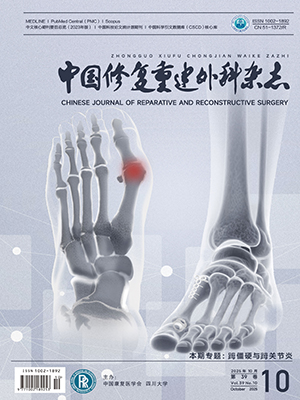| 1. |
Tan B, Li W, Zeng P, et al. Epidemiological study based on China Osteonecrosis of the Femoral Head Database. Orthop Surg, 2021, 13(1): 153-160.
|
| 2. |
Mont MA, Salem HS, Piuzzi NS, et al. Nontraumatic osteonecrosis of the femoral head: where do we stand today?: A 5-year update. J Bone Joint Surg (Am), 2020, 102(12): 1084-1099.
|
| 3. |
Cohen-Rosenblum A, Cui Q. Osteonecrosis of the femoral head. Orthop Clin North (Am), 2019, 50(2): 139-149.
|
| 4. |
Adapala NS, Yamaguchi R, Phipps M, et al. Necrotic bone stimulates proinflammatory responses in macrophages through the activation of toll-like receptor 4. Am J Pathol, 2016, 186(11): 2987-2999.
|
| 5. |
Andreev D, Liu M, Weidner D, et al. Osteocyte necrosis triggers osteoclast-mediated bone loss through macrophage-inducible C-type lectin. J Clin Invest, 2020, 130(9): 4811-4830.
|
| 6. |
张斌, 杨志刚, 杨晓斐, 等. 应用改良双套管脉冲持续冲洗结合负压封闭引流技术治疗骨髓炎. 骨科, 2017, 8(6): 433-438.
|
| 7. |
花然亮. 骨髓冲洗去除对骨形成影响的实验研究. 石家庄: 河北医科大学, 2008.
|
| 8. |
Alves do Monte F, Sung Park M, Gokani V, et al. Development of a novel minimally invasive technique to washout necrotic bone marrow content from epiphyseal bone: A preliminary cadaveric bone study. Orthop Traumatol Surg Res, 2020, 106(4): 709-715.
|
| 9. |
Kim HKW, Park MS, Alves do Monte F, et al. Minimally invasive necrotic bone washing improves bone healing after femoral head ischemic osteonecrosis: an experimental investigation in immature pigs. J Bone Joint Surg (Am), 2021, 103(13): 1193-1202.
|
| 10. |
中国微循环学会骨微循环专业委员会. 股骨头坏死临床诊疗技术专家共识(2022年). 中国修复重建外科杂志, 2022, 36(11): 1319-1326.
|
| 11. |
Hua KC, Yang XG, Feng JT, et al. The efficacy and safety of core decompression for the treatment of femoral head necrosis: a systematic review and meta-analysis. J Orthop Surg Res, 2019, 14(1): 306. doi: 10.1186/s13018-019-1359-7.
|
| 12. |
Saini U, Jindal K, Rana A, et al. Core decompression combined with intralesional autologous bone marrow derived cell therapies for osteonecrosis of the femoral head in adults: A systematic review and meta-analysis. Surgeon, 2023, 21(3): e104-e117.
|
| 13. |
Wang BL, Sun W, Shi ZC, et al. Treatment of nontraumatic osteonecrosis of the femoral head with the implantation of core decompression and concentrated autologous bone marrow containing mononuclear cells. Arch Orthop Trauma Surg, 2010, 130(7): 859-865.
|
| 14. |
刘树仁. 长管状骨髓腔冲洗对原发骨质疏松影响的实验研究. 石家庄: 河北医科大学, 2008.
|
| 15. |
Andre G, Boschetto F, Gokani V, et al. Ex vivo study of detergent-assisted intraosseous bone wash treatment of osteonecrosis. J Orthop Res, 2023, 41(7): 1482-1493.
|
| 16. |
Chan WP, Liu YJ, Huang GS, et al. MRI of joint fluid in femoral head osteonecrosis. Skeletal Radiol, 2002, 31(11): 624-630.
|
| 17. |
Iida S, Harada Y, Shimizu K, et al. Correlation between bone marrow edema and collapse of the femoral head in steroid-induced osteonecrosis. AJR Am J Roentgenol, 2000, 174(3): 735-743.
|
| 18. |
莫亮. 基于股骨头坏死“血瘀”理论探讨围塌陷期骨髓水肿的病理机制. 广州: 广州中医药大学, 2023.
|
| 19. |
Kim J, Lee SK, Kim JY, et al. CT and MRI findings beyond the subchondral bone in osteonecrosis of the femoral head to distinguish between ARCO stages 2 and 3A. Eur Radiol, 2023, 33(7): 4789-4800.
|
| 20. |
Meier R, Kraus TM, Schaeffeler C, et al. Bone marrow oedema on MR imaging indicates ARCO stage 3 disease in patients with AVN of the femoral head. Eur Radiol, 2014, 24(9): 2271-2278.
|
| 21. |
Hatanaka H, Motomura G, Ikemura S, et al. Differences in magnetic resonance findings between symptomatic and asymptomatic pre-collapse osteonecrosis of the femoral head. Eur J Radiol, 2019, 112: 1-6.
|




